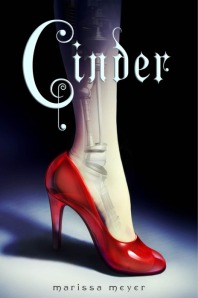“Even in the Future the story begins with Once Upon a Time.” – Marissa Meyer
Fairy tales are the stories many children are raised on. They are the narratives that they fall asleep to and influence their dreams. They have also had a huge influence on stories and writers for hundreds of years. But over the years, these stories have been altered to make them more culturally acceptable and less terrifying for the children who hear the stories. Marissa Meyer’s Cinder is one such story based off of the fairy tale Cinderella, although this is not a story for children, but for teens. It is set in the near future after World War IV, where very large and unified empires exist, technology is advanced and androids are a regular part of life. The story focuses on the title character Cinder, a cyborg who is hated by her stepmother and shunned by her society. Her job as a mechanic is the only income her family receives, but she is forced to give it all to her stepmother. She meets the prince and future emperor of the Eastern Commonwealth, Kai, in her job and so begins anything but an ordinary fairy tale story of love. Throughout the book, Kai and Cinder keep running into each other and Kai expresses his interest in Cinder, but she neglects to inform him of her cyborg nature due to the fear of being shunned. She spends the entire story hiding her mechanical limbs and keeping secrets from Kai. While she longs to be honest with Kai and connect with him, she continuously pushes him away.
The theme of prejudice runs strong throughout the story, especially when Cinder has her encounters with her stepmother Adri and stepsister Pearl. They show little care for Cinder and use her as more of a slave than a family member. Even the fellow shop owners at the market who know Cinder’s secret try to keep their distance. The prejudice that the culture shows towards cyborgs is even more ingrained because, when a disease begins ravaging the empire, a cyborg lottery is started where random cyborgs are brought in to scientists as guinea pigs to experiment on to find a cure. This prejudice is what keeps Cinder from revealing her secret to Kai and what creates a feeling of “otherness” in Cinder’s character. She feels like an outsider in her society and it is what drives her to try and escape from her family and start a new life with a rebuilt car she finds at the dump.
While the Cinderella adaptation is fairly well done, and Meyer mixes in the tropes of the Cinderella story fairly well into the story, in the end, it is a very predictable story. Meyer lays on the foreshadowing pretty thick and I knew what was going to happen in the story by the time Meyer revealed her first piece of foreshadowed story in the third chapter. Now that may be due to the fact that I often am analyzing stories and the fact that I read a lot of stories, so that may not be an issue for students. I think the heavy use of foreshadowing can be good for some students, as it provides them an opportunity to predict what is going to happen. Students who have inexperience with the concept of foreshadowing will be able to pick up on it well and have things to discuss in class and in their written responses.
While I did not overly enjoy Cinder, I think it definitely has its uses within Lit Circles. It has a strong theme about prejudice and the characters have enough depth to dig into them a bit. The foreshadowing is also helpful for students, although the story is quite predictable for more seasoned readers. I would recommend this book for grade 9 and higher, although strong younger readers could tackle the story as well. If I were to use this with Lit Circles, I would pair it with Scott Westerfeld’s Uglies or Leviathan, or Ally Condie’s Matched, because these books all deal with some sort of prejudice and even covering up or lying to stay safe. Cinder is an adapted fairy tale for fans of futuristic fiction and unrequited love stories.
